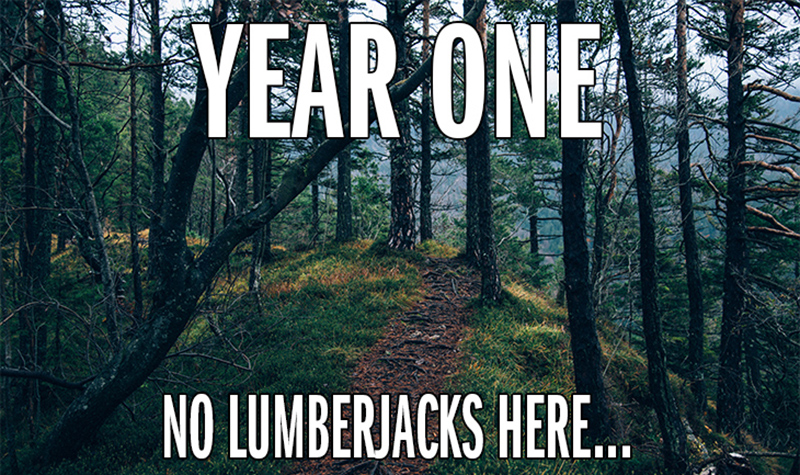 Yesterday, Not about Lumberjacks turned one year old.
Yesterday, Not about Lumberjacks turned one year old.
It started with a story about a dog who eats everything in sight: “Gutterball.” As I’ve mentioned elsewhere, I ended up writing more new stories in the first year of the show than I planned. And the way those new stories developed has surprised me quite a bit.
Once Upon a Time
There was a time when I worked in warehouses and factories and other jobs that allowed me to be in my head all day. Because of that, it was not uncommon to roll a story around in my head until it was almost fully realized up in my brainmeats.
I’d rush home and often knock out a story in a sitting. I’d give it a touch-up the next day, have a few trusted readers offer feedback — make any changes based on that feedback — and call the stories complete.
My process at the end is still largely unchanged — I polish the story once and hand it off to trusted readers — but other aspects of the process are much different.
Chunky Writing
As a technical writer, I can’t afford to roll stories around in my head all day at work anymore. I have to dedicate my brain to what I’m paid to do. The days of fully-realized stories in my head are long gone.
These days, I tend to break stories into chunks (using Scrivener). Then I jump into those little sections and make them whole. They often link themselves together quite well, and — eventually — I have a whole story.
I initially worried that the new(ish) process would result in stories that felt segmented, but what I’m writing feels more realized than older stories.
Chunky works! (For me, anyway…)
Different Endings
I suppose the biggest change to the way I write short fiction these days is the way endings come together. As I mentioned, I used to decide on an ending as I realized a story in my head when I worked menial jobs. Today, I have time to look at endings and think:
Is this the best way to go with this?
Case in point: “The Other Side.”
The story is about a recently divorced (and unemployed) guy who breaks into his childhood home to see if there’s still a portal to a magical realm in his old closet. My first thought was a rather typical ending: he’d go through the portal and rekindle an old potential romance…a happy-enough ending that would have been the ending years ago.
I knew that was quite typical, though…and let’s be real: stories about other realms are nice and all, but the reality is we’d all probably end up dead in a world where monsters roam freely. And so I thought:
- What if he realized the portal was never there — that it was all a false memory to cover up a horrible childhood?
- What if he went through and had no one to protect him this time?
- What if he went through and the magical realm had changed so much that it was unrecognizable?
- What if he didn’t go through at all?
Rolling all those potential endings around in my head, and having days to think about it because sometimes work is busy and demands more of my time, led to choosing a much better ending than:
Daniel goes through the portal and meets up with his childhood sweetheart on the other side.
The Simple Goal
I started Not about Lumberjacks to get me back to writing short fiction. Novels and work were the priority for years. Until I wrote the first new story for the show (fan-fave, “Horus”), I’d not written a short story in probably 6 or 7 years.
By forcing myself to a monthly schedule to produce a show featuring short fiction, I ended up writing more new stories in the first year than planned.
Next Year
I already have a pile of older stories on deck to go for next year should they be needed. (Work obviously pays the bills and sometimes demands a bit more time than usual — and during those times, it’s nice to fall back and revisit an older story.) But I also have a pile of ideas for new stories (and even pieces of stories) ready for next year as well.
Not about Lumberjacks did exactly what I hoped it would do, and I thank everybody who’s listened to a story or two in its first year…

Leave a Reply